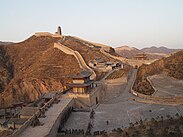
Back Shanxi ACE Shanxi Afrikaans شانشي Arabic Shanxi AST Şansi Azerbaijani Шаньсі Byelorussian Шаньсі BE-X-OLD Шанси Bulgarian শানশি Bengali/Bangla ཧྲན་ཞི་ཞིང་ཆེན། Tibetan
Shanxi
山西 | |
|---|---|
| Province of Shanxi | |
| Name transcription(s) | |
| • Chinese | 山西省 (Shānxī Shěng) |
| • Abbreviation | SX / 晋 (pinyin: Jìn) |
Clockwise from the top:
| |
 Map showing the location of Shanxi Province | |
| Coordinates: 37°42′N 112°24′E / 37.7°N 112.4°E | |
| Country | China |
| Named for | 山, shān – mountain 西, xī – west "west of the Taihang Mountains" |
| Capital (and largest city) | Taiyuan |
| Divisions | 11 prefectures, 119 counties, 1388 townships |
| Government | |
| • Type | Province |
| • Body | Shanxi Provincial People's Congress |
| • CCP Secretary | Tang Dengjie |
| • Congress chairman | Tang Dengjie |
| • Governor | Jin Xiangjun |
| • CPPCC chairman | Wu Cunrong |
| Area | |
| • Total | 156,000 km2 (60,000 sq mi) |
| • Rank | 19th |
| Highest elevation | 3,058 m (10,033 ft) |
| Population (2020)[2] | |
| • Total | 34,915,616 |
| • Rank | 18th |
| • Density | 220/km2 (580/sq mi) |
| • Rank | 19th |
| Demographics | |
| • Ethnic composition | Han – 99.7% Hui – 0.2% |
| • Languages and dialects | Jin, Zhongyuan Mandarin, Jilu Mandarin |
| GDP[3] | |
| • Total | CN¥ 1.765 billion US$ 255 billion |
| • Per capita | CN¥ 50,555 US$ 7,327 |
| ISO 3166 code | CN-SX |
| HDI (2019) | 0.752[4] (high) (16th) |
| Website | www.shanxigov.cn (in Chinese) |
| Shanxi | |||||||||||||||||||||||||||||||||||||
|---|---|---|---|---|---|---|---|---|---|---|---|---|---|---|---|---|---|---|---|---|---|---|---|---|---|---|---|---|---|---|---|---|---|---|---|---|---|
"Shanxi" in Chinese characters | |||||||||||||||||||||||||||||||||||||
| Chinese | 山西 | ||||||||||||||||||||||||||||||||||||
| Postal | Shansi | ||||||||||||||||||||||||||||||||||||
| Literal meaning | "West of the (Taihang) Mountains" | ||||||||||||||||||||||||||||||||||||
| |||||||||||||||||||||||||||||||||||||
Shanxi[a] is an inland province of China and is part of the North China region. The capital and largest city of the province is Taiyuan, while its next most populated prefecture-level cities are Changzhi and Datong. Its one-character abbreviation is "晋" (pinyin: Jìn), after the state of Jin that existed there during the Spring and Autumn period.
The name Shanxi means "West of the Mountains", a reference to the province's location west of the Taihang Mountains.[6] Shanxi borders Hebei to the east, Henan to the south, Shaanxi to the west and Inner Mongolia to the north. Shanxi's terrain is characterised by a plateau bounded partly by mountain ranges. Shanxi's culture is largely dominated by the ethnic Han majority, who make up over 99% of its population. Jin Chinese is considered by some linguists to be a distinct language from Mandarin and its geographical range covers most of Shanxi. Both Jin and Mandarin are spoken in Shanxi.
Shanxi is a leading producer of coal in China, possessing roughly a third of China's total coal deposits. Nevertheless, Shanxi's GDP per capita remains below the national average. The province hosts the Taiyuan Satellite Launch Center.
The province is also known for having by far the largest number of historic buildings among all Chinese provinces, by possessing over 70% of China's surviving buildings built during or predating the Song dynasty.[7] Also notable are the Yungang Grottoes in Datong, Shanxi, which date back over 1500 years.
- ^ "Geography". Shanxi Tourism Bureau. Archived from the original on 25 December 2018. Retrieved 5 August 2013.
- ^ "Communiqué of the Seventh National Population Census (No. 3)". National Bureau of Statistics of China. 11 May 2021. Retrieved 11 May 2021.
- ^ GDP-2020 is a preliminary data "Home - Regional - Quarterly by Province" (Press release). China NBS. March 1, 2021. Retrieved March 23, 2021.
- ^ "China National Human Development Report 2016" (PDF). United Nations Development Programme. 2016. p. 146. Retrieved 2017-12-05.
- ^ "Shanxi". Lexico UK English Dictionary. Oxford University Press. Archived from the original on May 18, 2021.
- ^ Wilkinson (2012), p. 234.
- ^ "地上文物看山西,太原纯阳宫"变身"山西古建筑博物馆". 13 April 2020.
Cite error: There are <ref group=lower-alpha> tags or {{efn}} templates on this page, but the references will not show without a {{reflist|group=lower-alpha}} template or {{notelist}} template (see the help page).
© MMXXIII Rich X Search. We shall prevail. All rights reserved. Rich X Search




